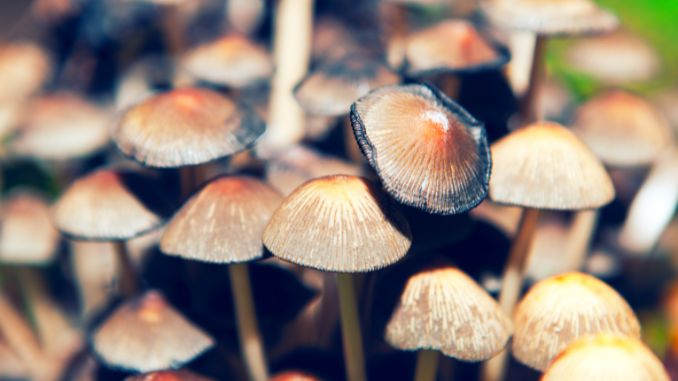Know in one minute about Coprinopsis atramentaria
|
Introduction
Coprinopsis atramentaria is a wild edible mushroom commonly found in Europe and North America. It is the second best-known ink cap, previously known as Coprinus atramentarius. It is a mushroom with a thin flash and mild taste. It mainly grows in vacant lots, lawns, and grassy areas. It arises just after the rain from spring to autumn, in clusters but sometimes as solitary as well (2).
Classification
| Kingdom | Fungi |
| Division | Basidiomycota |
| Class | Agaricomycetes |
| Order | Agaricales |
| Family | Psathyrellaceae |
| Genus | Coprinopsis |
| Species | C. atramentaria |
Common name
- Common ink cap
- Inky cap
- Tippler’s bane
Synonyms
Coprinopsis atramentaria
Agaricus plicatus pers
Coprinus plicatus (pers.) Gray
1. Agaricus atramentarius Bull
2. Agaricus luridus Bolton
3. Agaricus sobolifer Hoffmann
Appearance
Coprinopsis atramentaria is 3-10 cm in diameter.
Cap |
|
Gills |
|
Stem |
|
Spores |
|
Spore print |
|
Flesh |
|
Odour |
|
Taste |
|
Habitat |
|
Note: This Coprinopsis atramentaris or Tippler’s bane is similar to the Coprinus micaceus (Glistening inkcap), so do not confuse it with Coprinus micaceus while collecting Coprinopsis atramentaris for eating. The main difference is that Coprinus micaceus is smaller and redder when it is young.
Bioactive compounds
Bioactive compounds such as p-hydroxybenzoic (HA), coumaric (CoA), and cinnamic (CA) acid are found in the extract of Coprinopsis atramentaria. This mushroom also contains coprine which is a cyclopropyl glutamine compound. Coprine affects the autonomic β receptor and can cause vasomotor symptoms.
Nutritional value of Coprinopsis atramentaria
Nutritional components of Coprinopsis atramentaria per 100 gm is as follows
| Fat | 2.90± 0.03 |
| Protein % | 32.23 ±0.89 |
| Carbohydrate % | 48.55±0.21 |
| Crude fibre % | 19.7±0.09 |
| Sodium (mg/100g) | 39±0.34 |
| Potassium (mg/100g) | 422.±0.93 |
| Calcium (mg/100g) | 81±0.87 |
| Iron (mg/100g) | 39.0±0.32 |
| Copper (mg/100g) | 3.72±0.17 |
| Zinc (mg/100g) | 1.9±0.09 |
| Magnesium (mg/100g) | 39 ±0.31 |
| Manganese (mg/100g) | 0.8±0.05 |
Coprinopsis atramentaria: health benefits
It shows anti-tumor activity against sarcoma in the animal models. Polysaccharides are extracted from the mycelial culture of Coprinopsis atramentaria and administered to the mice, inhibiting the growth of cancerous cells (1).
1. Antioxidant activity of Coprinopsis atramentaria
Antioxidant substances protect the cell from free radicals that cause cell damage. The methanolic extract of this mushroom contains p- hydroxybenzoic acid, p- coumaric (CoA), and cinnamic acid which shows high antioxidant activity (2).
The polysaccharides and phenolic extract of Coprinopsis atramentaria have high antioxidant activity.
2. Cytotoxicity for tumorous cell
Cytotoxicity means the inhibition of the process of division and proliferation of cells. The extract of Coprinopsis atramentaria contains methylated and glucuronidase derivatives that show the cytotoxicity for MCF -7 breast adenocarcinoma, NCI- H460 non-small cell lung carcinoma HCT15- colon carcinoma, Hela – cervical carcinoma and HepG2- hepatocellular carcinoma (2).
3. Treatment for chronic alcoholism
The biochemical action and the symptoms occurring due to coprine are similar to the drug disulfiram, which is used for the treatment of chronic alcoholism.
4. Antibacterial activity
The methanol extract of Coprinopsis atramentaria shows antibacterial activity toward Escherichia coli, Pseudomonas aeruginosa, Salmonella typhi, Staphylococcus aureus, Bacillus subtilis and Micrococcus luteus (4).
Pseudomonas aeruginosa is a common bacteria that cause diseases in plants, animals as well as in humans. Its infection leads to tissue damage and reduced immunity. Salmonella typhi bacteria causes typhoid fever. Staphylococcus aureus and gram-positive bacterium are responsible for skin infection, respiratory infection, and food poisoning.
5. Antifungal activity
The methanolic extract of Coprinopsis atramentaria shows antifungal activity against the Penicillium ochrochloron, Aspergillus ochraceus, and penicillium verrucosum (3).
Aspergillus ochraceus produces ochratoxin A, which acts as a toxin and is responsible for food contamination. It shows chronic, neurotoxic, and carcinogenic effects in humans and animals.
6. To regulate general body mechanism
Coprinopsis atramentaria consist of minerals such as potassium, sodium, iron, iodine, copper, zinc, etc. which are important for general body mechanisms like osmoregulation, bone rigidity, the transmission of nerve impulse, and other metabolic reactions (4).
7. Demelanizing activity
The organic acid found in the extract of Coprinopsis atramentaria shows demelanizing activity on Aspergillus niger at a concentration of 0.030-0.100 mg/ml. The compound HAM1 and HAM3 shows their demelanizing activity on A. fumigatus at concentration of 0.030-0.100 mg/ml. where the compound CoAM1, CoAM2, HAM3, and CAM at 0.005- 0.05 mg/ml concentration shows demelanizing effect on P. verrucosum (3).
Medicinal benefits
This edible mushroom has important medicinal properties. It is used as a food supplement for promoting health. Coprinopsis atramentaria shows anti-tumorous, anti-fungal and antimicrobial activity. It has a low concentration of sodium therefore, it shows great nutritional benefits. This mushroom is a great source of iron, hence may help to decrease the incidence of anemia (4).
This mushroom is rich in mineral content, which is essential for the regulation of water and salt balance, the formation of rigid bones, nerve impulse transmission, and metabolic reactions (4).
Coprinopsis atramentaria: Side effects
Consuming Coprinopsis atramentaria after alcohol consumption results in disulfiram syndrome, which includes redness in the face, vomiting, agitation, palpitation, and tingling in limbs. Sometimes it causes heart attacks (myocardial infarction). Severity depends on the amount/ concentration of alcohol consumed.
This mushroom contains coprin ( cyclopropyl glutamine), which blocks the acetaldehyde dehydrogenase activity that leads to a hangover.
How to eat
Coprinopsis atramentaria is an edible mushroom but acts as poison when consumed with alcohol, therefore avoiding its consumption with alcohol. It is rich in nutrients; boiling or cooking does not affect its medicinal properties.
Written By: Neetu Ladiya
